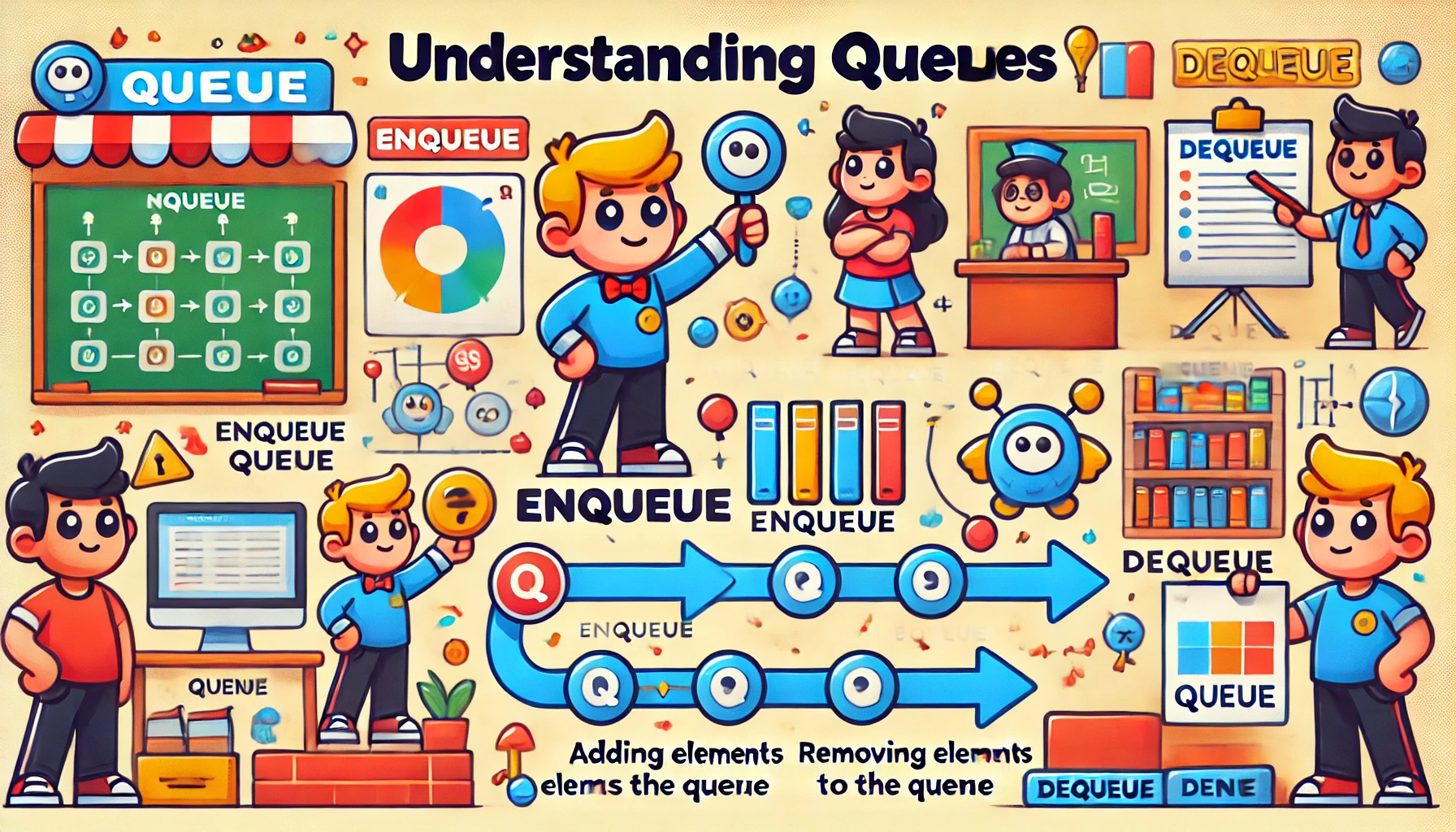Definition
A Queue is a simple yet powerful data structure used for storing and retrieving data in a First-In, First-Out (FIFO) manner. This means the first element added to the queue will be the first one to be removed.
Key Concepts
- Enqueue: Add an element to the end of the queue.
- Dequeue: Remove and return the first element of the queue.
- Peek/Front: Return the first element without removing it.
- isEmpty: Check if the queue is empty.
Example Code in Python
Here’s how you can implement a queue in Python using a list:
class Queue:
def __init__(self):
self.items = []
def is_empty(self):
return len(self.items) == 0
def enqueue(self, item):
self.items.append(item)
def dequeue(self):
if self.is_empty():
return None
return self.items.pop(0)
def peek(self):
if self.is_empty():
return None
return self.items[0]
def size(self):
return len(self.items)
# Example usage
queue = Queue()
queue.enqueue(1)
queue.enqueue(2)
queue.enqueue(3)
print(queue.dequeue()) # Output: 1
print(queue.peek()) # Output: 2
print(queue.is_empty()) # Output: FalseExample Code in JavaScript
Here’s the same queue implementation in JavaScript:
class Queue {
constructor() {
this.items = [];
}
isEmpty() {
return this.items.length === 0;
}
enqueue(item) {
this.items.push(item);
}
dequeue() {
if (this.isEmpty()) {
return null;
}
return this.items.shift();
}
peek() {
if (this.isEmpty()) {
return null;
}
return this.items[0];
}
size() {
return this.items.length;
}
}
// Example usage
const queue = new Queue();
queue.enqueue(1);
queue.enqueue(2);
queue.enqueue(3);
console.log(queue.dequeue()); // Output: 1
console.log(queue.peek()); // Output: 2
console.log(queue.isEmpty()); // Output: falseTips for Using Queues
- FIFO Principle: Always remember that queues operate on the First-In, First-Out principle. This is crucial for understanding how data is stored and retrieved.
- Use Cases: Queues are particularly useful for the following problems:
- Breadth-First Search (BFS): Used to traverse graphs or trees level by level.
- Task Scheduling: Used in operating systems to manage process scheduling.
- Buffering: Used in data stream processing as temporary storage for data.
- Print Queue: Managing the order of print jobs.
- Performance: Operations like enqueue and dequeue are generally O(1), making queues very efficient for adding and removing elements.
- Memory Use: Be mindful of the queue’s memory usage, especially in long-running programs.
Additional Use Cases for Queues
Queues are versatile data structures with various applications in computer science and software engineering. Here are some other use cases:
1. Breadth-First Search (BFS)
Breadth-First Search uses a queue to visit nodes of a graph or tree level by level. This is useful for pathfinding and shortest path problems.
Example in Python:
def bfs(graph, start):
visited = []
queue = [start]
while queue:
vertex = queue.pop(0)
if vertex not in visited:
visited.append(vertex)
queue.extend([neighbor for neighbor in graph[vertex] if neighbor not in visited])
return visited
graph = {
'A': ['B', 'C'],
'B': ['D', 'E'],
'C': ['F'],
'D': [],
'E': ['F'],
'F': []
}
print(bfs(graph, 'A')) # Output: ['A', 'B', 'C', 'D', 'E', 'F']2. Task Scheduling
In operating systems, queues are used to manage process scheduling, ensuring each process is handled in order.
3. Buffering
Queues are used in data stream processing as temporary storage for data, such as buffering network traffic.
4. Print Queue
In print management systems, queues manage print jobs, ensuring they are processed in the order received.
5. Level Order Traversal of Trees
Queues are used to implement level order traversal of trees, visiting nodes level by level.
Example in Python (Level Order Traversal):
class TreeNode:
def __init__(self, value):
self.value = value
self.left = None
self.right = None
def level_order_traversal(root):
if not root:
return []
result = []
queue = [root]
while queue:
level = []
for i in range(len(queue)):
node = queue.pop(0)
level.append(node.value)
if node.left:
queue.append(node.left)
if node.right:
queue.append(node.right)
result.append(level)
return result
# Example usage
root = TreeNode(1)
root.left = TreeNode(2)
root.right = TreeNode(3)
root.left.left = TreeNode(4)
root.left.right = TreeNode(5)
root.right.left = TreeNode(6)
root.right.right = TreeNode(7)
print(level_order_traversal(root)) # Output: [[1], [2, 3], [4, 5, 6, 7]]6. Web Crawler
In web crawlers, queues are used to manage URLs to be crawled, ensuring each URL is visited in order.
Conclusion
Queues are a fundamental data structure in computer science with various applications, from breadth-first search to task scheduling and data stream processing. By understanding the basic operations and principles, you can effectively utilize queues to solve a variety of computational problems. Whether you are using Python, JavaScript, or any other programming language, the concepts of queue operations remain consistent and are essential tools for efficient problem-solving.
Recommend Resources:
Introduction to the Queue Data Structure Coderbyte

Leave a Reply